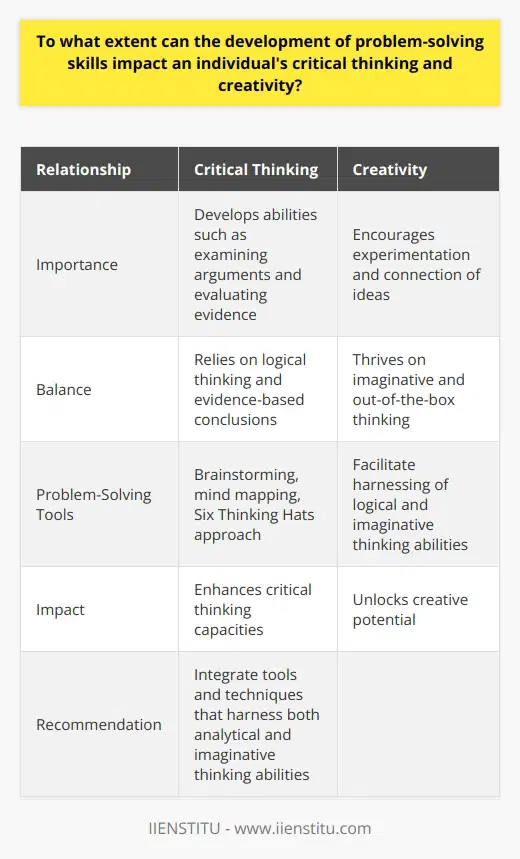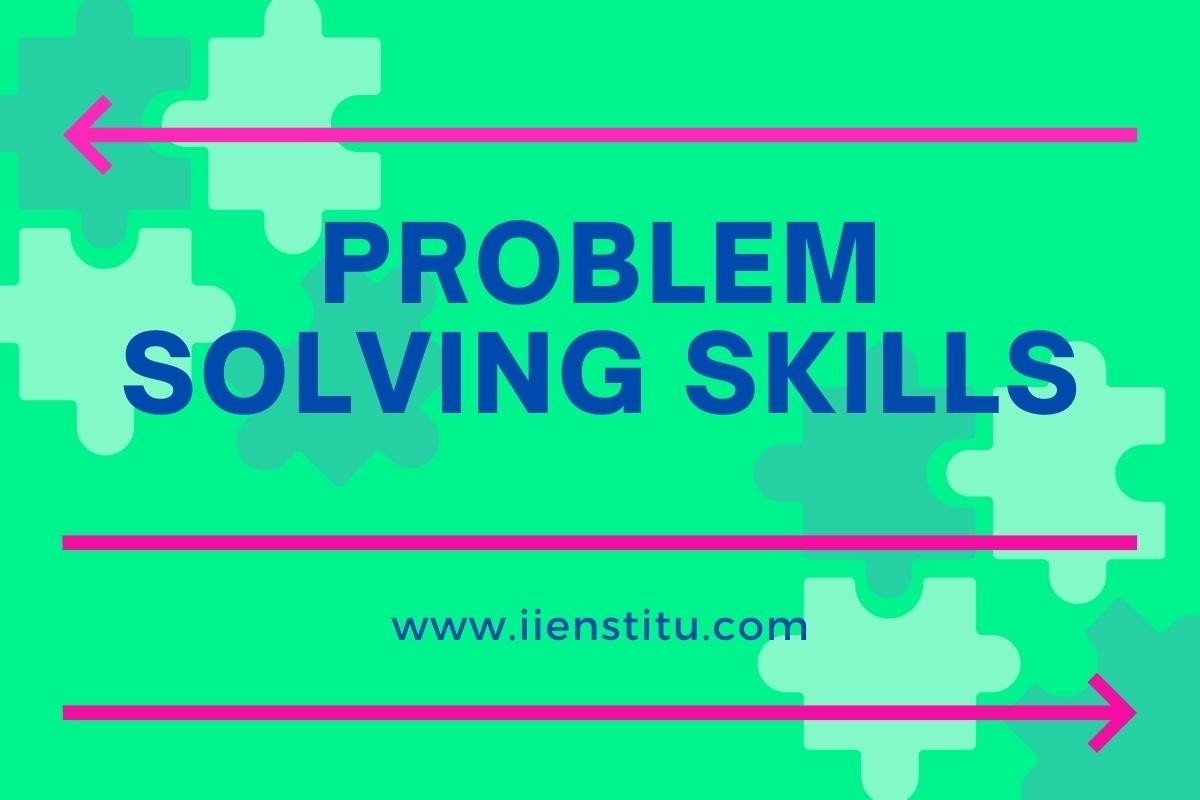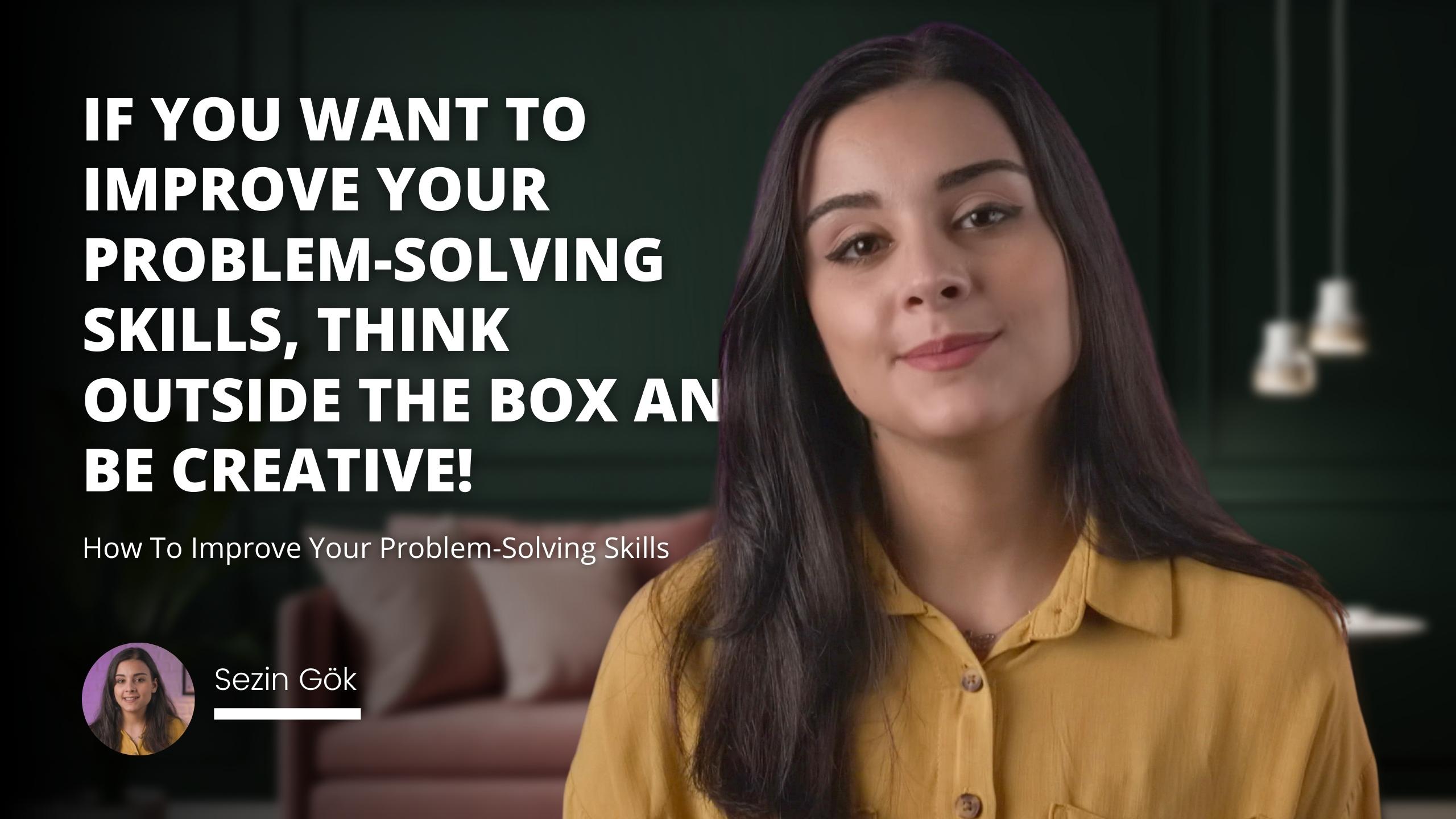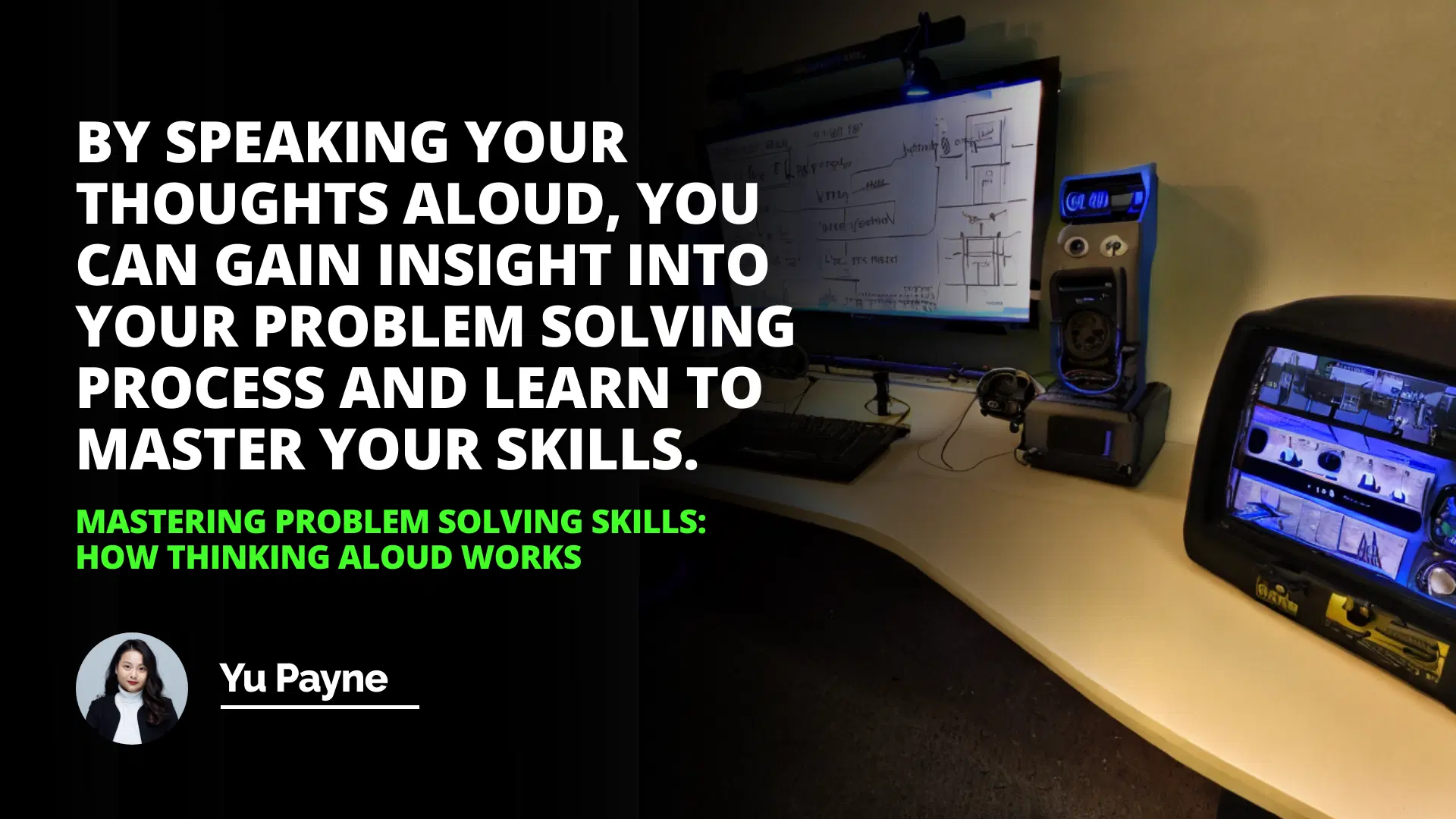
Learning a new skill can often be a daunting task. I still remember the first time I attempted to bake a soufflé. The kitchen was filled with exotic aromas, but my mind was clouded with uncertainty. The temptation to ask for a complete list of instructions to achieve perfection was immense. I wanted step-by-step guidance to ensure success. However, as with many things in life, this is not how learning works. Instead, most learning begins with a primary goal and lots of practice to master the details.
Introduction
What is Thinking Aloud Pair Problem-Solving?
How to Apply Thinking Aloud Pair Problem-Solving?
Benefits of Thinking Aloud Pair PrProblem-Solving
Conclusion
One effective strategy I've discovered over the years is Thinking Aloud Pair Problem-Solving (TAPPS). It's a simple yet powerful process that can help learners acquire new skills and knowledge quickly and efficiently. In this article, we'll delve into what TAPPS is, how to apply it, and the benefits it offers. By the end, you'll have a solid understanding of how this method can enhance your learning process.
What is Thinking Aloud Pair Problem-Solving?
At its core, Thinking Aloud Pair Problem-Solving is a collaborative learning technique where two individuals work together to solve a problem. It's based on the idea that when two people combine their thoughts and perspectives, they can generate more ideas and come up with better solutions than if they worked alone.
I recall an instance during my college days when my friend Jessica and I were struggling with a complex calculus problem. We decided to try thinking aloud together. As I verbalized my thought process, Jessica listened and occasionally chimed in with her own insights. Before we knew it, we had unraveled the problem that had stumped us for hours individually.
In TAPPS, there are two key roles:
1- The Thinker: This person is tasked with thinking aloud, describing their thought process step by step as they work through the problem. This could involve explaining their reasoning, strategies, and any challenges they encounter.
2- The Listener: The listener's role is to actively listen to the thinker's explanations. They offer feedback, support, and ideas to help the thinker progress. The listener may ask clarifying questions or gently guide the thinker if they seem stuck.
This process of externalizing thought and receiving immediate feedback helps deepen understanding. It's not just about solving the problem at hand but also about developing critical reasoning skills and enhancing overall learning.
Notably, TAPPS is grounded in cognitive psychology principles, particularly those related to metacognition, which is thinking about one's own thinking. By speaking aloud, the thinker becomes more aware of their cognitive processes, which can lead to improved analytical ability.
How to Apply Thinking Aloud Pair Problem-Solving
Applying TAPPS is straightforward, but to get the most out of it, it's essential to approach it thoughtfully. Here's a step-by-step guide to implementing this method:
1- Select an Issue or Task
Begin by identifying a problem or task you want to work on. It could be anything from a complex mathematical equation, a challenging coding bug, or even planning a project using the critical path method project management strategy. For example, if you're trying to optimize a project's timeline, TAPPS can help you analyze the critical path and consider potential bottlenecks.
Failure Mode, Effects, and Criticality Analysis (FMECA): A Comprehensive Guide
Problem Solving Model: A Comprehensive Analysis of Its Key Components
Ishikawa Diagram (Fishbone Diagram): A Comprehensive Guide to Effective Analysis
Ishikawa Diagram: A Comprehensive Guide to Cause and Effect Analysis
By speaking your thoughts aloud, you can gain insight into your problem-solving process and learn to master your skills.
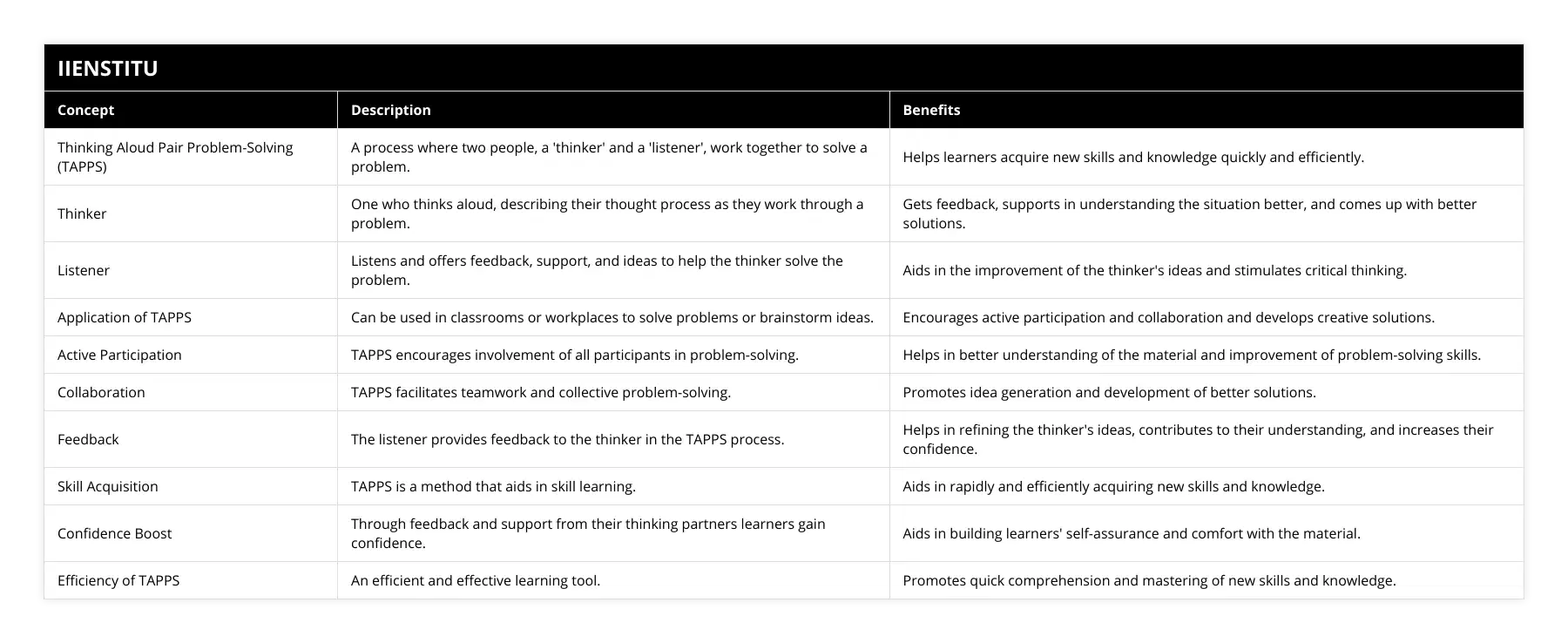
2- Assign Roles
Decide who will be the thinker and who will be the listener. These roles can switch in subsequent sessions to allow both participants to benefit from each perspective. It's important to be flexible and open to learning from each other.
3- Set Ground Rules
For the Thinker:
Verbalize every thought. Don't filter or second-guess yourself. Even seemingly insignificant thoughts can lead to breakthroughs.
Be open to feedback and suggestions. Remember, the goal is to enhance your understanding.
For the Listener:
Listen actively and attentively. Show that you're engaged through nods or brief affirmations.
Avoid interrupting the thinker unnecessarily. Allow them to express their thoughts fully.
Provide constructive feedback and ask probing questions. For instance, "Can you explain why you chose that approach?"
4- Begin the Problem-Solving Process
The thinker starts working through the problem, speaking aloud as they go. For example, if they're trying to debug a piece of code, they might say, "I'm checking the variable initialization here because I suspect it's causing a null reference." This verbalization helps clarify their thought process.
5- Engage in Collaborative Dialogue
The listener can interject with questions like, "Have you considered how this function interacts with that variable?" Such questions encourage the thinker to explore different avenues and enhance their critical thinking skills. It's crucial to foster an environment where both parties feel comfortable sharing ideas.
6- Reflect and Discuss
After the problem has been solved or the session ends, take time to reflect. Discuss what strategies worked, what challenges arose, and how the process could be improved next time. Reflection solidifies learning and highlights areas for further development.
Benefits of Thinking Aloud Pair Problem-Solving
The TAPPS method offers numerous benefits that can significantly enhance learning and problem-solving abilities.
Improves Critical Thinking
By externalizing thoughts, the thinker engages in critical thinking and self-examination of their reasoning processes. This method helps in developing a deeper understanding of the problem and the underlying principles. It forces one to explain critical thinking processes explicitly, which can uncover any gaps in understanding.
Enhances Analytical Skills
Both the thinker and the listener sharpen their analytical abilities as they dissect the problem together. This collaborative environment fosters an atmosphere where logical reasoning and critical analysis are paramount. Analytical skills are essential in many fields, from engineering to finance.
Encourages Active Learning
TAPPS promotes an active learning environment. Instead of passively receiving information, learners are actively involved in the problem-solving process, making the learning experience more engaging and effective. Active participation leads to better retention and application of knowledge.
Builds Communication Skills
Verbalizing thoughts requires clarity and coherence, which helps improve communication skills. The listener also hones their ability to provide feedback and ask insightful questions. These skills are invaluable in both personal and professional settings.
Facilitates Knowledge Transfer
Working in pairs allows for the exchange of ideas and perspectives. The listener might introduce new concepts or alternative approaches that the thinker hadn't considered, broadening both participants' understanding. This collaborative approach can create a learning community where knowledge is shared and expanded.
Boosts Confidence
Successfully solving problems together can boost confidence. The support and validation from a partner can encourage learners to tackle more challenging tasks in the future. Confidence is a key component in effective problem-solving and decision-making.
Develops Critical Reasoning Skills
TAPPS helps in developing critical reasoning skills by encouraging learners to evaluate their thought processes critically. This skill is essential for making reasoned judgments and decisions.
Acts as an Issue Solver
This method can act as an effective issue solver by providing a structured approach to tackle problems. By methodically working through each step, learners can address complex issues more efficiently.
Personal Experience with TAPPS
Allow me to share a personal experience that highlights the effectiveness of TAPPS. Recently, I was involved in a project at work that required analyzing a large dataset to identify trends. My colleague, Alex, and I decided to use TAPPS to tackle this task.
I took on the role of the thinker, while Alex was the listener. As I navigated through the data, I verbalized my observations, hypotheses, and uncertainties. "I'm noticing a spike in sales in the third quarter, but I'm not sure what's driving it," I said. Alex listened attentively and then asked, "Could it be related to the marketing campaign we launched during that time?"
This prompted me to dig deeper, and together we uncovered that the spike was indeed correlated with our marketing efforts. By thinking aloud and collaborating, we not only identified key trends but also generated actionable insights for our business strategy.
This experience reinforced the value of TAPPS in professional settings, especially where critical thinking and collaboration are essential.
Tips for Effective TAPPS Sessions
To maximize the benefits of TAPPS, consider the following tips:
Choose the Right Partner
Work with someone who is supportive, attentive, and willing to engage fully in the process.
Create a Comfortable Environment
Ensure that the setting is free from distractions and conducive to open communication.
Set Clear Goals
Define what you aim to achieve in the session. Having a clear objective keeps the discussion focused.
Be Patient
Allow time for thoughts to develop. Don't rush the process.
Practice Regularly
Like any skill, regular practice improves proficiency. Incorporate TAPPS into your routine learning activities.
Critical Thinking in TAPPS
The TAPPS method inherently promotes critical thinking thinking, which might sound redundant but emphasizes the depth of critical engagement required. It's not merely about thinking critically; it's about thinking about how you think critically.
According to the critical thinking definition provided by educational psychologists, it involves analyzing facts to form a judgment. TAPPS facilitates this by making thoughts explicit and subject to examination.
For those unfamiliar with critical thinking, it can be described as:
Analyzing: Breaking down complex information into understandable components.
Evaluating: Assessing the validity and reliability of information.
Synthesizing: Combining different ideas to form a new whole.
Description of Critical Thinking in TAPPS
In the context of TAPPS, critical thinking manifests as:
Questioning Assumptions: The listener might challenge the thinker's assumptions, prompting deeper analysis.
Exploring Alternatives: Both participants consider different solutions or approaches.
Reflecting on Process: After the session, reflecting on how the problem was approached and solved enhances learning.
Conclusion
Thinking Aloud Pair Problem-Solving is more than just a technique; it's a collaborative approach that fosters deeper understanding and skill mastery. By engaging in TAPPS, learners actively participate in the learning process, which is crucial for retaining information and developing critical reasoning skills.
I can personally attest to the effectiveness of TAPPS. During a recent project at work, my colleague and I were tasked with designing a new feature for our software application. By thinking aloud together, we explored various options, anticipated potential issues, and ultimately developed a robust solution. Not only did we achieve our goal, but we also enhanced our analytical skills and strengthened our teamwork.
In a world that increasingly values collaboration and critical thought, methods like TAPPS are invaluable. Whether you're a student, a professional, or someone keen on personal development, incorporating TAPPS into your learning strategies can lead to significant benefits.
By speaking your thoughts aloud, you can gain insight into your problem-solving process and learn to master your skills.
References
Johnson, D. W., & Johnson, R. T. (1994). Learning Together and Alone: Cooperative, Competitive, and Individualistic Learning. Allyn and Bacon.
Vygotsky, L. S. (1978). Mind in Society: The Development of Higher Psychological Processes. Harvard University Press.
Sweller, J. (1988). Cognitive load during problem solving: Effects on learning. Cognitive Science, 12(2), 257-285.
Mayer, R. E. (2011). Applying the Science of Learning. Pearson.
Brookfield, S. D. (2012). Teaching for Critical Thinking: Tools and Techniques to Help Students Question Their Assumptions. Jossey-Bass.
Frequently Asked Questions
What is the purpose of Thinking Aloud Pair Problem Solving?
Thinking Aloud Pair Problem Solving (TAPPS) is a tool used to facilitate problem-solving. It is a method of collaboration between two people that encourages the use of thinking aloud to brainstorm and generate ideas to solve a problem. The purpose of TAPPS is to provide a structure for problem-solving that fosters collaboration, creativity, and critical thinking.
The TAPPS process begins with a problem to be solved, which can be identified through various techniques, such as brainstorming, mind mapping, or open-ended questioning. Once the problem is identified, the two participants in the TAPPS process take turns thinking aloud, offering their ideas and solutions to the problem. This process is essential as it allows the two participants to generate ideas and solutions they may not have thought of alone.
The Thinking Aloud Pair Problem Solving process also encourages collaboration and teamwork. By sharing their ideas and solutions, the two participants can work together to identify the best solution to the problem. Through this process, they can come up with more creative and effective solutions than they may have thought possible.
The Thinking Aloud Pair Problem Solving process also encourages critical thinking. The two participants can evaluate their ideas and develop the best solution to the problem by discussing their ideas and solutions. Through this process, they can gain a better understanding of the problem and come up with a more comprehensive solution than they may have been able to do on their own.
In conclusion, Thinking Aloud Pair Problem-Solving is a powerful tool for problem-solving. It encourages collaboration, creativity, and critical thinking, allowing the two participants to generate ideas and solutions they may not have thought of alone. It also promotes cooperation and teamwork, allowing the two participants to work together to identify the best solution to the problem. Finally, it promotes critical thinking, allowing the two participants to understand the situation better and come up with a more comprehensive solution than they may have been able to do on their own.

How can Thinking Aloud Pair Problem Solving help me improve my problem solving skills?
Thinking Aloud Pair Problem Solving (TAPPS) is an effective technique for improving problem-solving skills. TAPPS is a collaborative problem-solving activity that involves two people working together to solve a problem. The two people “think aloud” while they work together to solve the problem. By talking through the pain and sharing ideas, each person can help the other come up with a solution.
TAPPS can help improve problem-solving skills in several ways. First, it encourages active participation and discussion. During a TAPPS session, the participants actively engage in the problem-solving process. They discuss the problem and explore different solutions. This process helps to increase their understanding of the problem and the various approaches that can be taken to solve it.
Second, TAPPS allows the participants to practice their communication skills. During the problem-solving process, the participants must communicate their ideas and opinions to each other. This gives them a chance to practice effective communication and learn how to explain their ideas effectively.
Third, TAPPS encourages creative thinking. The participants can explore different approaches to the problem and generate new ideas. This helps to expand their problem-solving skills and encourages them to think outside of the box.
Finally, TAPPS provides an enjoyable and collaborative way to learn. By working together, the participants can have fun while they learn and practice problem-solving skills. This can help to make the learning process more enjoyable and engaging.
Overall, TAPPS is a powerful tool for improving problem-solving skills. It encourages active participation, facilitates effective communication, encourages creative thinking, and provides an enjoyable and collaborative learning experience. Using TAPPS, learners can gain valuable problem-solving skills and become better problem-solvers.
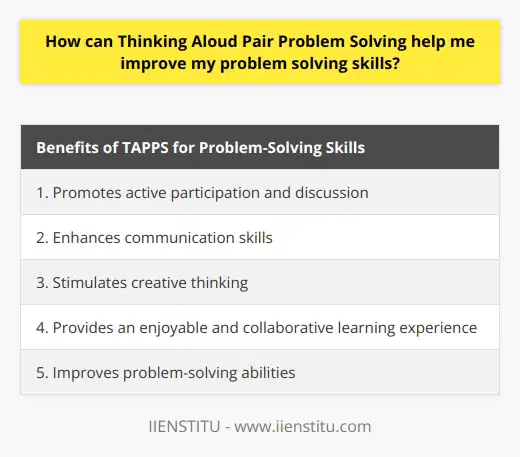
What are the benefits of using Thinking Aloud Pair Problem Solving?
Thinking Aloud Pair Problem Solving (TAPPS) is an interactive problem-solving strategy used in various educational and professional fields. This strategy involves two people working together to problem solve and think aloud about their solutions. This technique is beneficial in several ways.
First, TAPPS improves communication and collaboration. By thinking aloud, each participant can hear the other person’s ideas and contribute their own. As a result, this type of problem-solving encourages open and honest communication, which leads to more effective collaboration.
Second, TAPPS encourages critical thinking and problem-solving skills. By thinking through solutions together, participants can develop creative solutions they may not have thought of individually. This type of problem-solving can also help participants identify potential issues, brainstorm possible solutions, and develop strategies for solving the problem.
Third, TAPPS can help increase motivation and engagement. By working together, participants can support and encourage each other, which can help them stay engaged and motivated. Additionally, this type of problem-solving can help participants identify their strengths, which can help them become more self-confident and engaged in the problem-solving process.
Finally, TAPPS can help participants develop their interpersonal skills. By working together, participants can develop their ability to listen, share ideas, and compromise. This can help them become better communicators and team players in the future.
Overall, Thinking Aloud Pair Problem-Solving is a beneficial strategy ttohelp participants improve their communication, collaboration, critical thinking, problem-solving skills, motivation, engagement, and interpersonal skills. This strategy can be used in various educational and professional fields to help participants develop these essential skills.
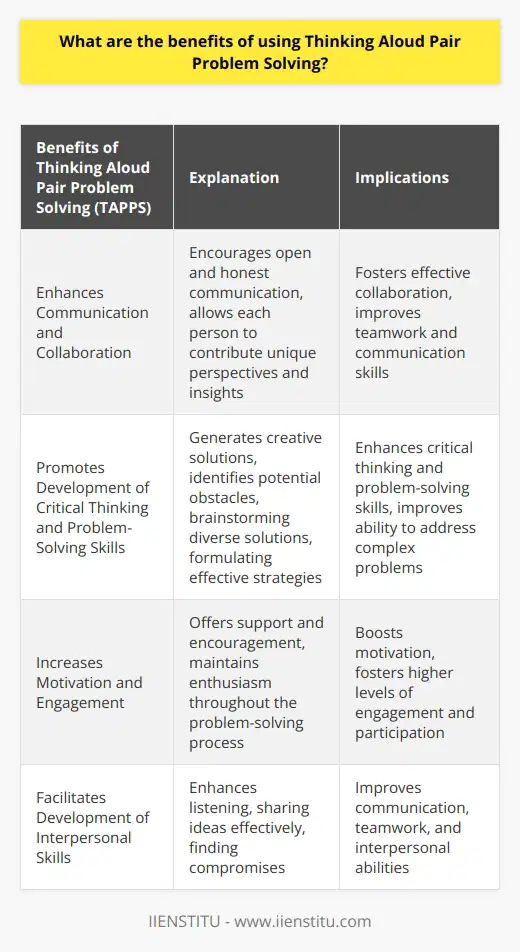
What is the thinking aloud strategy in problem-solving?
Defining the Thinking Aloud Strategy
The thinking aloud strategy in problem-solving is a crucial cognitive technique that involves verbalizing one's thought process while attempting to solve a problem. This approach aids individuals in better understanding their cognitive processes and facilitates improved decision-making. Moreover, it allows for monitoring and analyzing of the problem-solving steps, fostering the development of advanced cognitive skills.
Applications of the Thinking Aloud Strategy
Often utilized in educational settings, the thinking aloud strategy encourages students to articulate their thoughts as they work through problems, helping teachers and peers to better understand the reasoning and logic behind the student's actions. In turn, this process facilitates feedback and support by identifying potential areas for improvement or misconceptions. Additionally, in research settings, this technique provides qualitative data regarding participants' cognitive processes, aiding in the development of theories and models for problem-solving.
Improving metacognitive abilities
By engaging in the thinking aloud strategy, individuals can enhance their metacognitive abilities, enabling them to improve their self-awareness, planning, and self-regulation in the problem-solving process. This cognitive approach helps individuals to identify gaps in their knowledge, address misunderstandings, and build a more profound comprehension of the problem at hand. Moreover, the thinking aloud technique fosters the development of adaptive problem-solving strategies, enabling individuals to apply these skills effectively and efficiently to diverse problem domains.
Promoting critical thinking and reflection
The thinking aloud strategy encourages critical thinking and reflection by helping individuals to better comprehend their thought process and evaluate whether their reasoning is valid and sound. By actively engaging in verbalizing their cognitive process, individuals are more likely to engage in conscious, deliberate, and systematic problem-solving. As a result, the thinking aloud technique promotes a deeper understanding of the problem, encourages self-reflection, and helps develop high-level critical thinking skills that are essential for academic and professional success.
In conclusion, the thinking aloud strategy is a valuable technique for enhancing problem-solving abilities, fostering metacognitive development, and promoting critical thinking and reflection. By verbalizing one's thought process during problem-solving, individuals can better understand, monitor, and refine their reasoning and approach, ultimately leading to improved decision-making and cognitive skills.
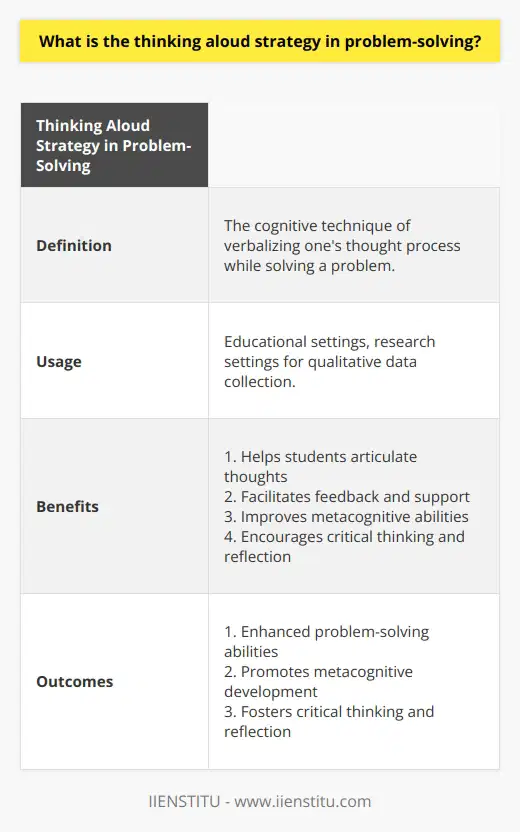
How do you master problem-solving skills?
Recognizing Challenges
To master problem-solving skills, one must begin by recognizing the challenges or obstacles that they encounter. Identifying the issues at hand is crucial to create a structured and targeted approach to address them effectively.
Breaking Down Complexities
Next, breaking down complex problems into smaller, manageable components is key. Analyzing each sub-problem separately allows for a more in-depth understanding and provides a clear roadmap for potential solutions.
Doing Thorough Research
It's essential to conduct comprehensive research to gather information and resources necessary to tackle problems skillfully. By seeking out pertinent knowledge and examining case studies, one can better appreciate the problem's context and develop informed strategies for resolution.
Developing Critical Thinking Skills
Cultivating critical thinking skills is crucial for problem-solving mastery. This includes discerning patterns, formulating logical arguments, and evaluating the validity of solutions. These abilities enable individuals to approach problems with a structured mindset, leading to credible resolutions.
Seeking Collaboration and Feedback
Collaborating with peers and seeking constructive feedback can dramatically improve problem-solving capabilities. Engaging in discussions allows for multiple perspectives and the opportunity to refine one's approach in response to valuable insights.
Regular Practice
Finally, continuous practice is pivotal for enhancing one's problem-solving proficiency. Tackling various types and scales of problems enables an individual to adapt and grow in their abilities. Regular engagement with challenges can provide a deeper understanding of diverse strategies and methods.
In conclusion, mastering problem-solving skills requires an active and focused approach. Recognizing challenges, breaking down complexities, conducting thorough research, cultivating critical thinking skills, seeking collaboration and feedback, and practicing regularly are all essential components in fostering the ability to overcome obstacles and arrive at effective solutions.
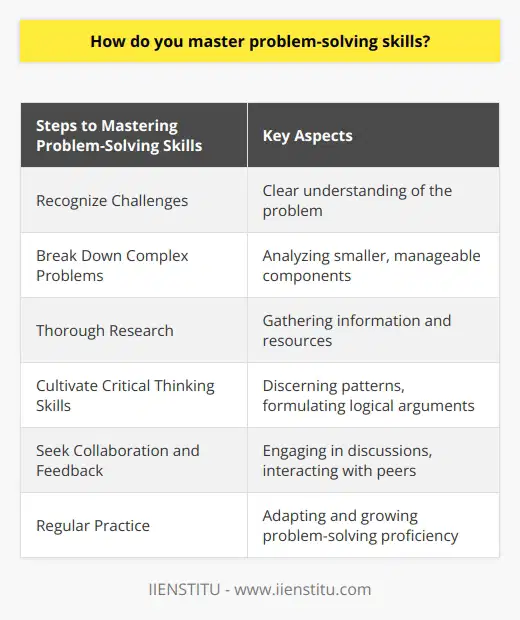
How does thinking a problem out loud affect people's problem-solving abilities?
The Effect on Problem-solving Abilities
Thinking a problem out loud, also known as verbalizing, has significant effects on people's problem-solving abilities. When individuals vocalize their thoughts and thought process, it benefits them in several ways.
Enhancing Cognitive Processing
First, verbalizing promotes enhanced cognitive processing. As individuals explain their thought process, they are forced to structure their thoughts coherently. This additionally allows for deeper reflection and connection with their inner problem-solving mechanisms, ultimately leading to a more effective solution.
Facilitating Memory Retrieval
Second, talking through a problem can facilitate memory retrieval. When people discuss their thoughts, ideas, or relevant experiences aloud, they stimulate their memory and recall more pertinent information. This leads to increased access to critical knowledge and resources for solving the problem at hand.
Promoting Self-monitoring
Third, verbalizing one's thoughts promotes self-monitoring. Individuals who think out loud tend to become more aware of their thought process, which enables them to catch errors and adjust their approach accordingly. Increased self-awareness also allows for the identification of mental roadblocks, such as faulty assumptions or biases, that may be impeding problem resolution.
Encouraging Collaborative Problem-solving
Lastly, speaking about a problem enables collaborative problem-solving. Sharing ideas and information with others provides an opportunity to gather feedback, offer alternative solutions, and refine one's approach. This collective knowledge enhances the overall problem-solving process and increases the likelihood of identifying the most effective solution.
Obstructions to Verbalizing
While verbalization has evident benefits, its effectiveness can be hindered by several factors. These include fear of judgment from others, lack of proficiency in verbal communication, and environmental constraints that do not permit speaking aloud. It is essential to consider and address these factors to maximize the gains from verbalizing one's thoughts during problem-solving.
In conclusion, verbalizing thoughts while working on a problem leads to improved problem-solving abilities as it enhances cognitive processing, facilitates memory retrieval, promotes self-monitoring, and encourages collaboration. However, it is crucial to address possible obstructions to effectively capitalize on the benefits of thinking a problem out loud.
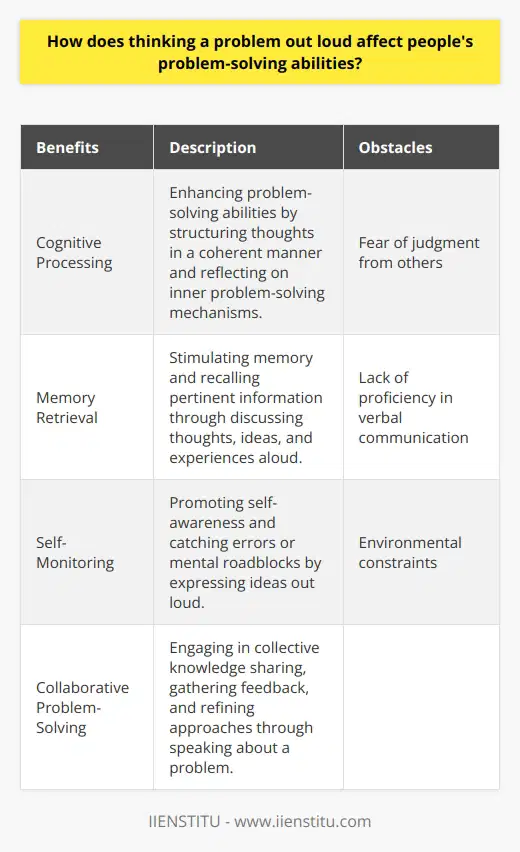
How can problem-solving skills help a student develop their thinking skills?
The Importance of Problem-Solving Skills
Problem-solving skills play a pivotal role in shaping a student's cognitive abilities. These skills help students tackle complex tasks, improve critical thinking, and sharpen decision-making abilities. Consequently, problem-solving skills empower students to become accomplished thinkers.
Enhancing Critical Thinking
Adept problem solvers analyze situations from multiple perspectives, promoting critical thinking development. By evaluating different viewpoints and evidence, students become capable of making informed decisions. Additionally, fostering critical thinking through problem-solving enables students to question assumptions and recognize biases, ultimately helping them become adaptive learners.
Encouraging Creativity
Problem-solving also boosts a student's creative capabilities. Tackling challenges requires students to brainstorm various approaches and solutions, instilling innovative thought processes. This nurtures imaginative thinking, allowing students to devise novel ways of addressing complex academic or real-life situations.
Facilitating Decision-Making Skills
Effective problem-solving entails making informed choices between different alternatives. As students develop problem-solving abilities, they can better assess the merits and demerits of each option, thereby improving their decision-making skills. Such competencies prove invaluable in academic and professional environments, where making sound choices is paramount.
Developing Persistence and Resilience
As students confront various obstacles and setbacks while solving problems, they learn to persevere and refine their strategies. This cultivates resilience, enabling them to approach future challenges with increased confidence and determination. Consequently, they become adept at facing adversity in both academic and personal settings.
Promoting Communication and Collaboration
Problem-solving often involves working in teams or groups, allowing students to develop communication and collaborative skills. Students learn to express their ideas cogently and listen to alternative viewpoints. By working together to arrive at solutions, they form crucial interpersonal skills that enhance their overall thinking abilities.
In conclusion, problem-solving skills are integral to a student's intellectual growth, fostering critical thinking, creativity, decision-making abilities, persistence, and enhanced communication. By nurturing these competencies, educators empower students to succeed not only academically but also in various aspects of their personal and professional lives.
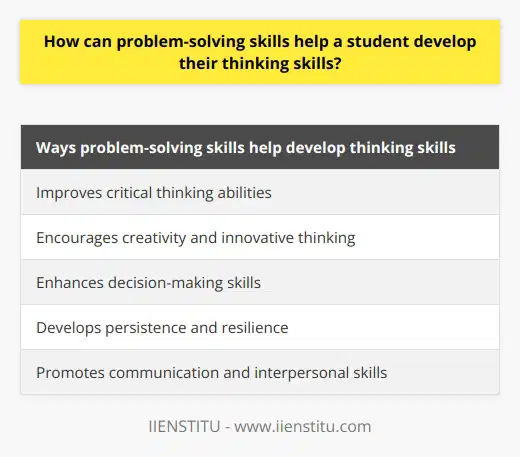
What is using thinking skills to suggest a solution to a problem called?
Definition and Importance
The process of using thinking skills to suggest a solution to a problem is called problem-solving. Problem-solving is an integral part of everyday life and a crucial component in various fields, including education, business, and the sciences. Developing effective problem-solving abilities allows individuals to navigate the complexities of the world, adapt to changing circumstances, and creatively address challenges.
Cognitive Processes Involved
Several cognitive processes underlie problem-solving, including decision-making, critical thinking, and analytical reasoning. Decision-making involves selecting the best course of action from multiple alternatives, whereas critical thinking refers to a systematic and logical evaluation of information. Analytical reasoning, on the other hand, focuses on breaking down complex problems into manageable components for a more comprehensive understanding.
Types of Thinking Skills
To solve problems effectively, individuals employ different types of thinking skills, such as convergent and divergent thinking. Convergent thinking focuses on reaching a single, well-established answer by evaluating and analyzing existing information. In contrast, divergent thinking fosters creativity and idea generation by exploring multiple perspectives and solutions.
Strategies for Enhancing Problem-Solving
To improve problem-solving abilities, several strategies can be adopted. These include:
Identifying the problem: Clearly defining the issue fosters understanding and lays the foundation for generating solutions.
Gathering information: Collecting relevant data, facts, and opinions helps to better understand the problem and potential solutions.
Brainstorming: Encourage creativity and open-mindedness through the generation of multiple ideas and approaches.
Evaluating alternatives: Weighing the pros and cons of each potential solution to determine the most practical and effective option.
Implementing the solution: After selecting the best approach, put it into action and monitor its effectiveness.
Reflecting on the outcome: Assess the results to identify areas of improvement, success, and learning.
In conclusion, problem-solving is a vital skill in today's complex world. By understanding the cognitive processes involved and employing various thinking skills, individuals can tackle a wide range of challenges and develop solutions that demonstrate creativity and adaptability. As a result, developing effective problem-solving abilities contributes to personal and professional growth, enhanced decision-making, and increased overall satisfaction in life.
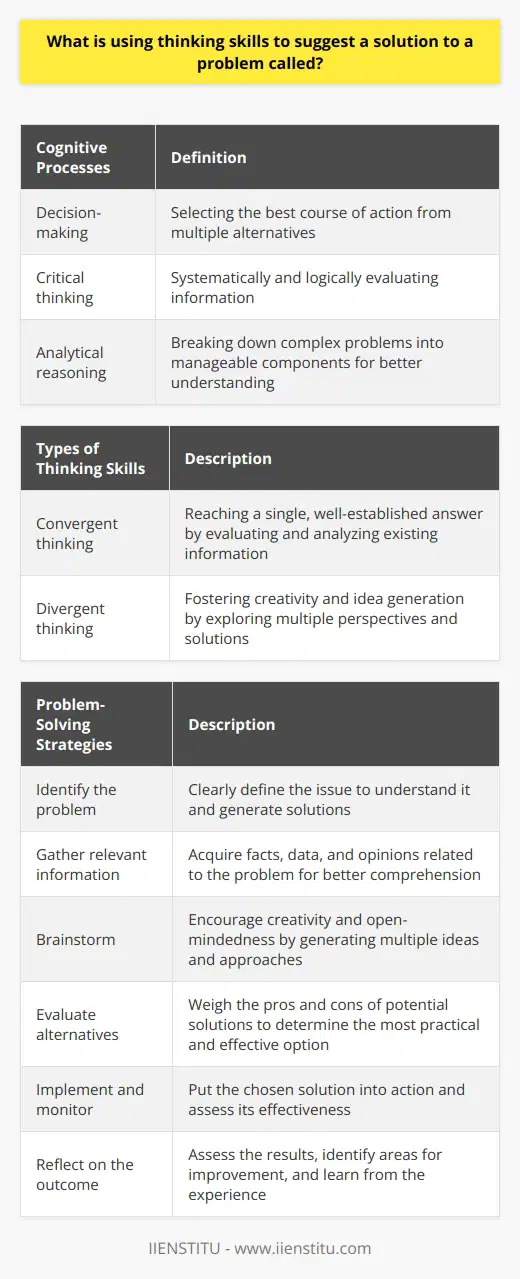
How does the implementation of the thinking aloud strategy in problem-solving enhance cognitive processes in learners?
Enhancing Cognitive Processes through Thinking Aloud
The thinking aloud strategy involves verbalizing one's thoughts as they engage in problem-solving tasks. Implementing this technique can significantly enhance cognitive processes in learners by providing several key benefits.
Increased Metacognitive Awareness
Thinking aloud allows students to actively monitor and evaluate their thought process, leading to heightened metacognitive awareness. This self-regulation ability empowers learners to recognize ineffective strategies, adjust their approach, and ultimately, become more efficient problem-solvers.
Improved Working Memory Function
By verbalizing their thoughts, learners are able to unload some of the cognitive demands associated with problem-solving onto their auditory and linguistic processing systems. This frees up working memory resources and allows for more effective information processing and integration.
Facilitating Cognitive Strategy Development
Using the thinking aloud strategy encourages students to adopt a structured and organized approach to problem-solving by identifying individual steps and processes. This fosters the development of cognitive strategies that can be honed and refined over time, leading to more sophisticated, higher-order thinking skills.
Enhanced Cognitive Flexibility
Through the externalization of their thought process, learners may become more aware of alternative perspectives and approaches. This promotes cognitive flexibility, enabling them to consider multiple solutions, adapt to changing conditions, and solve problems more effectively.
Promoting Collaborative Learning
The thinking aloud technique can also facilitate collaboration and peer learning by making the thought process visible to others. This creates opportunities for shared problem-solving, constructive feedback, and reciprocal teaching, which can strengthen overall cognitive skills for all participants.
In conclusion, implementing the thinking aloud strategy in problem-solving settings can significantly enhance cognitive processes in learners by promoting metacognitive awareness, improving working memory function, facilitating cognitive strategy development, fostering cognitive flexibility, and encouraging collaborative learning. By consistently employing this technique, educators can equip students with critical skills necessary for success in a wide range of academic and real-world problem-solving situations.
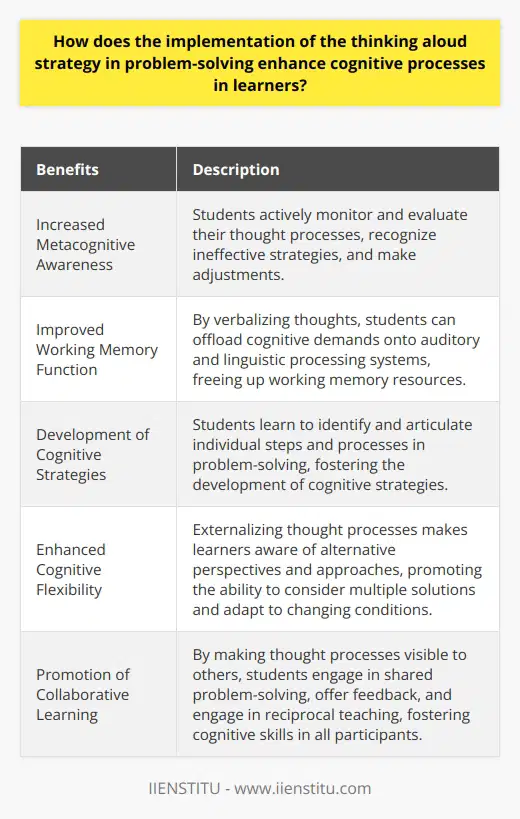
What are 3 key attributes of a good problem solver?
### Analytical Skills
The first key attribute of an effective problem solver is the possession of strong analytical skills. In order to resolve complex issues, individuals need the ability to critically evaluate information, identify underlying patterns or structures, and formulate logical connections. These skills enable problem solvers to break down a problem into its essential components, which can then be addressed in a more manageable and systematic manner.
### Adaptability and Open-Mindedness
A good problem solver is also adaptable and open-minded. This means being able to change one's approach when necessary or considering new perspectives when tackling a problem. An adaptable problem solver is not confined to a single way of thinking, but actively explores multiple strategies and modifies their methods as needed. An open-minded individual remains receptive to feedback, is willing to learn from mistakes, and does not hesitate to question preconceptions in the pursuit of an effective solution.
### Effective Communication
Finally, effective communication is crucial to successful problem-solving. Good problem solvers recognize that they must clearly articulate their thoughts, ideas, and strategies, ensuring that they are understood by others collaborating on the issue. This skill involves the ability to listen to others, process received information, and express oneself with clarity and precision. In fostering a collaborative atmosphere, effective communication enables problem solvers to work together efficiently and avoid any misunderstandings that may hinder the path to a desirable outcome.
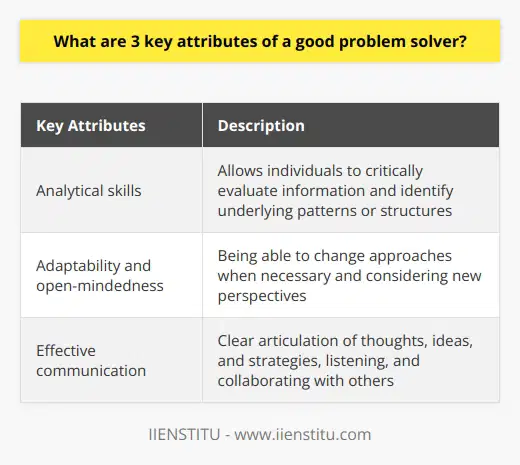
How can the thinking aloud strategy in problem-solving improve communication and collaboration among team members?
The Role of Thinking Aloud Strategy in Problem Solving
The thinking aloud strategy is a technique where individuals vocalize their thought processes while solving problems, and it can significantly improve communication and collaboration among team members. This method fosters an environment of openness and transparency, which is essential for effective teamwork. By explicitly expressing their ideas and thought processes, team members can understand each other's perspectives and offer insightful feedback.
Enhancing Mutual Understanding
One key benefit of thinking aloud is that it promotes mutual understanding among team members. When individuals articulate their thought processes, it allows others to grasp their reasoning, making it easier to find common ground and reach consensus. This shared understanding leads to increased empathy and a stronger sense of collaboration within the team.
Facilitating Effective Feedback
Another advantage of the thinking aloud strategy is its ability to facilitate effective feedback. As team members share their thoughts openly, there is ample opportunity for peers to provide constructive criticism and suggestions. This process encourages open dialogue and a growth mindset, which are crucial for both individual and team development.
Streamlining Decision Making
Thinking aloud also aids in streamlining the decision-making process. As team members verbalize their thoughts, they make their assumptions explicit, enabling others to challenge or support them more effectively. This process ensures that all team members are on the same page and helps to minimize misunderstandings that could impede progress.
Promoting Inclusiveness
Lastly, thinking aloud fosters a more inclusive environment by empowering all team members to contribute to the problem-solving process. When individuals feel heard and validated, they are more likely to actively participate in discussions and share their perspectives. This inclusive approach leads to a richer understanding of the problem and more innovative solutions.
In conclusion, the thinking aloud strategy can significantly improve communication and collaboration among team members by promoting mutual understanding, facilitating effective feedback, streamlining decision-making, and fostering inclusiveness. Implementing this technique in problem-solving discussions can lead to more productive and successful teamwork.

To what extent can the development of problem-solving skills impact an individual's critical thinking and creativity?
Impact on Critical Thinking
The development of problem-solving skills significantly impacts an individual's critical thinking abilities. By nurturing problem-solving skills, individuals learn to systematically identify and understand complex problems, assess the feasibility of possible solutions, and evaluate the consequences of their actions. This process enhances one's ability to think critically, as it entails examining arguments, questioning assumptions, and assessing evidence before reaching conclusions.
Interplay with Creativity
Moreover, problem-solving skills can also positively influence an individual's creativity. As individuals work on overcoming challenges, they often experiment with different approaches and ideas, which can lead to innovative solutions. This experimentation fosters curiosity and encourages individuals to explore and connect disparate concepts, ultimately enhancing their creative thinking abilities.
Balancing Critical Thinking and Creativity
However, it is essential to strike a balance between critical thinking and creativity in the problem-solving process. While critical thinking emphasizes logical thinking and evidence-based conclusions, creativity thrives on outside-the-box thinking and imagination. To effectively solve problems, individuals must incorporate both analytical thinking and creative exploration to generate practical yet innovative solutions.
Role of Problem-solving Tools
Problem-solving tools, such as brainstorming, mind mapping, and the Six Thinking Hats approach, can also facilitate the development of critical thinking and creativity. These tools encourage individuals to harness their logical reasoning and imaginative thinking abilities, enabling them to cultivate well-rounded problem-solving skills.
Conclusion
In summary, the development of problem-solving skills can have a profound impact on an individual’s critical thinking and creativity. By fostering their abilities to identify, analyze, and solve complex problems, individuals can enhance their critical thinking capacities, unlock their creative potential, and develop effective strategies to overcome challenges. To further support the growth of critical thinking and creativity through problem-solving, individuals should integrate tools and techniques that harness both analytical and imaginative thinking abilities.
